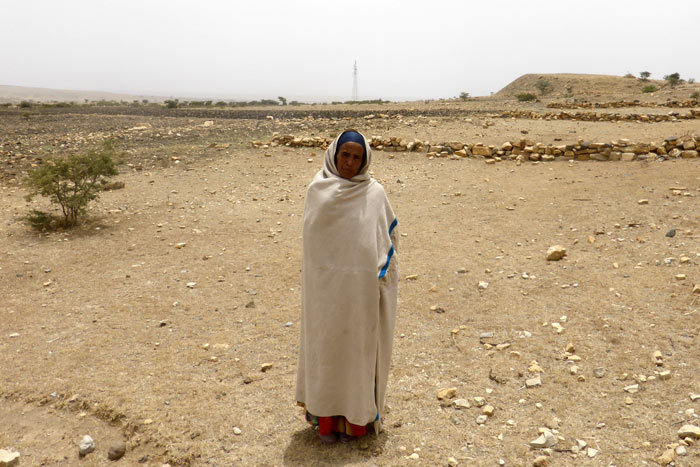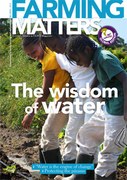Farming communities worldwide relate to water in myriad ways. The experiences here highlight grassroots initiatives focused on equitable use and distribution of water, community restoration of degraded ecosystems and innovative water saving techniques.
Nepal: Community participation

In 2009, 35 people started the Nava Durga Agricultural Cooperative. With some financial support they built a 600,000 litre rainwater storage tank, enabling 34 members of the newly formed ‘water users group’ to grow vegetables during the dry season and some to rear cattle. This success inspired an ambitious new project. The water users group almost doubled and the cooperative moved to set up the Pakhu Khola Dharapani Lift Irrigation Project.
A focus on equitable distribution of water has allowed 70 % of the village households to increase crop production and diversity and village out-migration has reduced. The community’s success started with inclusive participation and leadership – women are well represented in decision-making positions. The formation of cooperative governance structures also enabled them to build a network with public and private institutions that supported their work. And lastly, owing to the bottom-up nature of the irrigation project, it fit holistically into the community’s own vision of development.
For more information contact Ganesh Dhakal (gk.dhakal@gmail.com) or Chiranjibi Rijal (csrijal@gmail.com).
Portugal: Water retention landscapes
Bernd Müller, a water specialist in the community of Tamera, southern Portugal explains: “there is enough water for all people and animals if we follow the logic of nature rather than the laws of capital.” In the summer of 2007, the community faced conditions that were typical of the region: hot, dusty, bare soil. The winter rains had eroded the fertile topsoil, aquifers dried up, and the fire hazard was high. But today the situation is drastically changed.
A perennial creek is flowing again, ponds, lakes, and ditches filled during the winter. And, vegetables and fruit trees grow even at the hottest and driest time of the year. How did they achieve this turnaround? Across 150 ha, they created a water retention landscape. This involved building a series of ditches, lakes and ponds. But they also planted many trees and modified cultivation practices adds community member, Christoph Ulbig: “the lakes are beautiful icons of our work, but the actual effect is the result of the many little things we do.
Reforestation, working the ground parallel to contours, and other means which slow down the runoff of water.” Water retention is a basic principle which allows water time to infiltrate the soil, and ultimately restore degraded ecosystems. It can and is being applied worldwide.
For more information about water retention, including seminars, contact ecology@tamera.org.
Nigeria: Fish and vegetables save
In the northern part of Cross River State of Nigeria, farmers in Obudu are enjoying the benefits of integrated fish and vegetable production. The approach is simple: waste water from fish farms around the homestead is no longer considered waste. Thanks to decomposed and uneaten foods and faeces of the fish, it is rich in nutrients and can be used to irrigate vegetables. How did this concept take off? In 2012, a group of researchers led a multistakeholder project during which time the importance of fish farming and conservation of water for agriculture became apparent. Integrating fish and vegetable production showed potential to improve farmers’ livelihoods within the bounds of water scarcity and minimal external inputs.
Young farmers clubs, churches, cooperatives and age grade associations got involved and helped to build low-cost infrastructure including holes, pots, ponds and vats for the fish. Ninety eight farmers have embraced this initiative and experience the benefits directly. Efficient use of local resources – vegetables irrigated with waste water from fish farming don’t need chemical fertilizers – has improved food and nutrition security through year-round availability of healthy vegetables and fish. To enable more farmers to take up this system, improved access to fingerlings and water for the fish farms is needed.
For more information contact Marcel Ugbong Agim (agimmarcel@gmail.com).
Bangladesh: Water saving technology for paddy rice
As water is becoming increasingly scarce in rice producing regions, concerns are growing about how to improve water use efficiency of the crop. With the alternate wetting and drying technology developed by the International Rice Research Institute (IRRI) together with partners, 15-30 % of irrigation water can be saved. But the way in which farmers in Bangladesh pay for water presented a ‘disincentive’ for them to try the technology. Farmers normally pay for water as a fixed amount or as a share of the crop harvested, typically about 25 %, no matter how much or how little water they use.
To make water saving beneficial to farmers, IRRI works with groups of farmers in Bangladesh to facilitate deals between pump owners and farmers to allow payment for water on the basis of the volume supplied. In the 2014 winter season, 341 farmers using the alternate wetting and drying technology saved about a sixth of their irrigation expenses and raised grain yields by 5 %. In addition, greenhouse gas emissions from their fields have been halved compared with continuous flooding. The pump owners also gained as they had surplus water to sell and could increase their number of clients. This experience will be built on to upscale the use of the technology.
For more information contact Bjoern Ole Sander (b.sander@irri.org) or visit www.knowledgebank.irri.org and https://ccafs.cgiar.org/publications/alternate-wettingand-drying-irrigated-rice.


